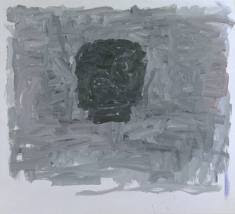 |
| Pieter Bruegel the Elder, Christ and the Woman Taken in Adultery, 1565 |
In all the years I have spent in and around London, I have
never been to the Courtauld Gallery. I went on Saturday to see one painting,
Pieter Bruegel The Elder’s Christ and the
Woman Taken in Adultery, 1565, the small, exquisite panel that was stolen
in 1982. I was surprised that while the gallery everywhere draws attention to
Manet’s Bar at the Folies Bégères,
and iconic images such as van Gogh’s Self-Portrait
With Bandaged Ear (1889), were well
signposted, Christ and the woman taken in
Adultery hangs quietly in a corner, drawing little attention to itself, and
for those not aware of its uniqueness in the history of art, it could be easily
missed.
 |
| Detail of Pieter Bruegel the Elder, Christ and the Woman Taken in Adultery, 1565 |
The tiny oil painting on a wood panel is apparently meant to
be viewed in private. How curious that so public a story, so profound a moral
lesson be intended for personal or private consumption. The understatement of
its size and grey hues are like the secret that will be revealed in private,
when up close to this delicate depiction. Like so many paintings from the
Renaissance onwards that are executed in grey, Bruegel’s becomes pink as we get
closer. The clothes, the ground on which Christ writes in Dutch that “whosoever
among you who has not sinned must cast the first stone” at the adulterous woman
is also a soft smokey pink. The pink, together with the brilliance of oil on
wood means that, yet again, the grey is anything but somber and dull. This is a
gentle and very quietly perfect painting that radiates in a corner, as if
resisting its overshadow by larger, chromatic works.
 |
| detail of Pieter Bruegel the Elder, Flight into Egypt, 1563 |
The neighboring Landscape with the Flight
into Egypt, also by Bruegel from 1563, two years earlier, is larger,
brighter in colour, with Mary’s red dress as she moves through the constantly
changing landscape drawing all the attention. Nevertheless, this painting is just
as fine as its grey neighbour, just as detailed, exquisite in the quietness and
serenity of the characters. Indeed, it is the intricacy of the landscape and
the figures in motion through that landscape that draw us up close. When I look
at these paintings, the centuries between me and Bruegel evaporate, all the
mundanities of my daily life subside, and I feel the calm of the painter
putting colour on a canvas. Like Christ
and the Woman taken in Adultery this is a resolutely public historical, or
rather, biblical painting that asks us to move up close and experience it in
private. The details of the trees, every painted flourish of Mary’s cape, the
figures, the birds in the trees, all of them are so delicately formed, awaiting
our most focused attention. One asped that I love about Bruegel’s paintings
from this period is that the figures are never looking, they are always busy
doing something. It is as though the peasants from the bigger paintings are
transported into biblical settings, and put to work. For me, these two tender images were the
highlight of the galleries.
 |
| Joshua Reynolds, Cupid and Psyche, 1789 |
Even though the collection is not large, it is vast because it spans Western
painting from the medieval to the second world war. As always with historical
collections that are arranged chronologically, the expanse is overwhelming and
difficult to take in. I have never been good at synthesizing hundreds of years
and hundreds of works of art. That said, after spending time with the Bruegels,
I wandered and discovered another work that I loved: Joshua Reynolds' Cupid and Psyche, 1789. As the mortal
Psyche discovers her heavenly lover, the secrecy of their tryst is held tightly
in a pool of light. They are held in a space that is closed by the brilliance
of the light ostensibly emanating from the candle Psyche holds to Cupid’s
sleeping, eroticized body. Next to his languid pose, her tense, outstretched
hand expresses a surprise so striking that we feel her experience. The moon outside
the window also makes this painting cinematic: in the darkened and secret
internal space, it is necessary to see with a torch. There are traces of
Georges de la Tour from over one hundred years earlier: the faces are not so
important, but rather, it is the world opened up by the light and the secrets
revealed therein that carry all meaning for this painting.
 |
| Edouard Manet, A Bar at the Folies-Bergère, 1881-82 |
And then there is Manet’s A Bar at the Folies-Bergère (1881-82). No matter how well I assume
to know a painting, there is nothing like seeing it in the flesh. Always,
everything is revealed when face to face with the colour, with paint on a
canvas and the details that no photographic reproduction can approach. My first
response to this iconic image was, no wonder
it has fascinated photographers since the day it was painted. The unsettling
use of reflection, the curious appearance of the acrobat’s legs along the top
of the painting, the distorted reflections of the man and the woman through the
use of a mirror image, all of it is as wonderous in the flesh as it is familiar
on the page of a book. And then there is the intense melancholy that overwhelms
the painting, the roughness of the crowd, and the same mottled grey counter on
which the woman leans that might be transposed directly to a painting by Jasper
Johns. All of a sudden, I could see so clearly why this painting still stands
as one of the great late nineteenth-century masterpieces.









